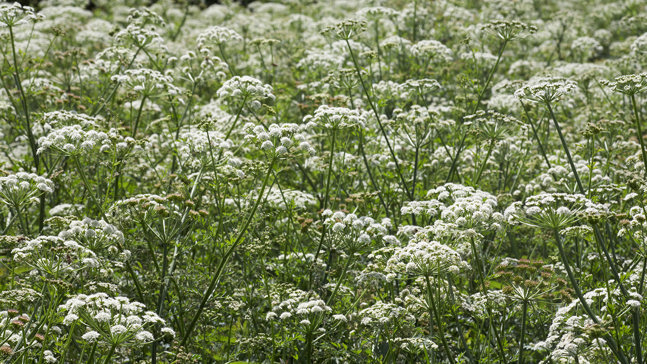
Credit: Carolyn Jenkins / Alamy Stock Photo
Where to find cow parsley
Cow parsley is a fast-growing plant found throughout the UK. It prefers shaded areas so hedgerows and woodland edges are common places to spot it.
A true roadside stunner, cow parsley is a familiar sight in the UK. It’s a hardy plant which is popular with pollinators and grows just about anywhere.
Common names: cow parsley, Queen Anne's lace, mother die, fairy lace, lady’s lace, hedge parsley
Scientific name: Anthriscus sylvestris
Family: Umbellifers
Origin: native
Flowering season: April to June
Habitat: woodland, grassland, urban areas, gardens
A short-lived perennial, the cow parsley is tall with sprays of white flowers, and commonly grows on verges.
Leaves: cow parsley leaves are strongly divided in shape, with an alternate leaf arrangement.
Flowers: its flowers are umbels – clusters of flowers with stalks which come from a common centre. Each flower is around six centimetres in diameter and white in colour.
Not to be confused with: fool’s parsley (Aethusa cynapium), which can be distinguished from cow parsley by the bracteoles (leaf-like structures) that are found underneath the flower head; upright hedge-parsley (Torilis japonica) which flowers later than cow parsley – from around July to September – and is smaller in size; wild carrot (Daucus carota) which at a distance may look like cow parsley but has an umbel that is made up of many florets, frequently with a purple one in the middle; and hemlock (Conium maculatum) which has leaves similar to those of cow parsley but sports a stem spotted with purple markings and is much bigger, growing to around two metres (careful – this species is poisonous).

Credit: Carolyn Jenkins / Alamy Stock Photo
Cow parsley is a fast-growing plant found throughout the UK. It prefers shaded areas so hedgerows and woodland edges are common places to spot it.
Young leaves of the plant are edible, but as it has so many poisonous relatives, it is best left uneaten!
Cow parsley is important for a variety of insects, including bees and hoverflies, as it is an early source of pollen. It is also a food plant for the moth Agonopterix heracliana and a nectar source for orange-tip butterflies.
The alternative name for cow parsley is Queen Anne’s lace. This harks back to a folk tale that the flowers would bloom for Queen Anne and her ladies in waiting and reflect the delicate lace they wore.

Credit: Matthew Maran / naturepl.com
Cow parsley was used in traditional medicines and is said to help treat various ailments, such as stomach and kidney problems, breathing difficulties and colds. It has always been used as mosquito repellent.
Another vernacular name,' Mother die' or 'Mummy die', was used to frighten children into thinking that if they picked cow parsley, their mother would die. This was intended to deter children from potentially picking deadly hemlock.
Discover wildflowers when you're out and about with your mini pocket guide to the UK's common woodland plants.
Visit our shop